Leptanilloides gracilis
| Leptanilloides gracilis | |
|---|---|

| |
| Scientific classification | |
| Kingdom: | Animalia |
| Phylum: | Arthropoda |
| Class: | Insecta |
| Order: | Hymenoptera |
| Family: | Formicidae |
| Subfamily: | Dorylinae |
| Genus: | Leptanilloides |
| Species: | L. gracilis |
| Binomial name | |
| Leptanilloides gracilis Borowiec & Longino, 2011 | |
The type series was collected in second growth mesophyll cloud forest. A few dozen workers were in a single “miniWinkler” sample, which is litter sifted from a 1m2 plot on the forest floor. Two additional workers were collected in a similar mini-Winkler sample approximately 1 km distant. The species occurred in two of 100 mini-Winkler samples taken at the site. The Guatemala collection was made under similar circumstances, in which a small series of workers occurred in one of 100 mini-Winkler samples from a mature cloud forest habitat. (Borowiec and Longino 2011)
Identification
A member of the Leptanilloides biconstrictus species-group.
Borowiec and Longino (2011) - Worker relatively slender and small compared to most species in the genus, promesonotal connection complete and articulated, abdominal segment III large relative to petiole, lateroclypeal tooth present, sculpturing moderate, parafrontal ridge present, flange overhanging metapleural gland opening pointed posteriorly. L. gracilis is unique in the modified petiolar spiracle, opening to a conspicuous pit larger in diameter than propodeal spiracle opening (Figure 3G), maxillary palpus with only one segment and mid and hind tibia with two simple spurs. In general habitus and size it is most similar to Leptanilloides femoralis but can be distinguished (in addition to traits mentioned above) by the pointed flange over the metapleural gland (blunt in L. femoralis) and relatively slender femur. Both L. gracilis and L. femoralis are similar to Leptanilloides biconstrictus from Bolivia and Leptanilloides improvisus from Ecuador, but can be distinguished by the distinctly bulging sternite of the petiole, with the bulge most prominent medially (versus indistinctly broadened anteriorly in L. biconstrictus and L. improvisus).
L. gracilis is unique in some traits that may be considered autapomorphies of this species. It has the segments of the maxillary palpus fused to form one, instead of the two-segmented palpus seen in other species where the palp formula is known. The petiolar spiracle opening is situated in a conspicuous pit of diameter larger than the propodeal spiracle opening; in all other species of Leptanilloides the petiolar spiracle opening is simple and subequal or smaller than that of propodeal spiracle. There are two minute, simple spurs on the mid and hind tibia, while other species of the genus are known to have one simple spur on the mid tibia and a single conspicuously pectinate spur on hind tibia.
Keys including this Species
Distribution
Latitudinal Distribution Pattern
Latitudinal Range: 16.15974° to 9.4817844°.
| North Temperate |
North Subtropical |
Tropical | South Subtropical |
South Temperate |
- Source: AntMaps
Distribution based on Regional Taxon Lists
Neotropical Region: Costa Rica, Guatemala, Honduras, Mexico (type locality), Nicaragua.
Distribution based on AntMaps
Distribution based on AntWeb specimens
Check data from AntWeb
Countries Occupied
| Number of countries occupied by this species based on AntWiki Regional Taxon Lists. In general, fewer countries occupied indicates a narrower range, while more countries indicates a more widespread species. |

|
Estimated Abundance
| Relative abundance based on number of AntMaps records per species (this species within the purple bar). Fewer records (to the left) indicates a less abundant/encountered species while more records (to the right) indicates more abundant/encountered species. |

|
Biology
Castes
Images from AntWeb
   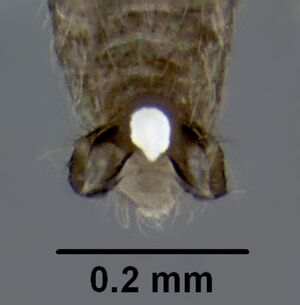
| |
| Male (alate). Specimen code casent0234558. Photographer Marek Borowiec, uploaded by UC Davis Ant Group. | Owned by JTLC. |

| |
| Specimen code casent0234561. . | |
   
| |
| Holotype Leptanilloides gracilis. Worker. Specimen code casent0234574. Photographer Marek Borowiec, uploaded by UC Davis Ant Group. | Owned by MCZC. |
   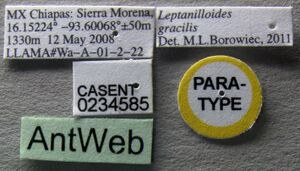    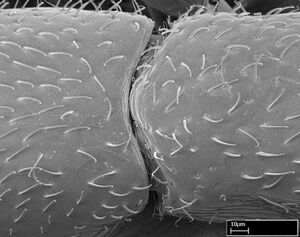
| |
| Paratype Leptanilloides gracilis. Worker. Specimen code casent0234585. Photographer Marek Borowiec, uploaded by UC Davis Ant Group. | |
  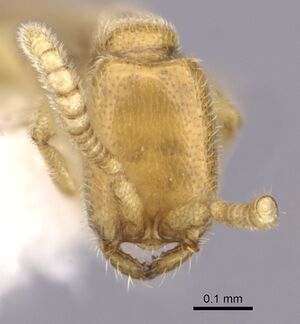 
| |
| Worker. Specimen code casent0249448. Photographer Will Ericson, uploaded by California Academy of Sciences. | Owned by PSWC, Philip S. Ward Collection. |
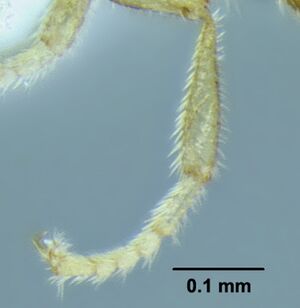
| |
| Specimen code casent0612940. . | |
Nomenclature
The following information is derived from Barry Bolton's Online Catalogue of the Ants of the World.
- gracilis. Leptanilloides gracilis Borowiec, M.L. & Longino, 2011: 33, figs. 1F, 2J, 5A-I (w) MEXICO (Chiapas), GUATEMALA.
- Type-material: holotype worker, 10 paratype workers.
- Type-locality: holotype Mexico: Chiapas, Sierra Morena, 1330 m., 16.15224°, -93.60068° ±50 m., 12.v.2008, Project LLAMA Wa-A-01-2-22 (no collector’s name); paratypes with same data.
- Type-depositories: MCZC (holotype); AMNH, BMNH, CASC, CFSS, EAPZ, FMNH, LACM, MZSP, UCDC, USNM, UVGC (paratypes).
- [Note: 10 paratypes, but 11 paratype depositories cited.]
- Status as species: Delsinne, et al. 2015: 8 (in key).
- Distribution: Guatemala, Mexico.
Unless otherwise noted the text for the remainder of this section is reported from the publication that includes the original description.
Description
Worker
(holotype): HW 0.25, HL 0.33, SL 0.15, MH 0.15, ML 0.44, PrW 0.17, PW 0.10, PL 0.13, AIIIW 0.15, AIIIL 0.12, AIVW 0.24, AIVL 0.19, FFeW 0.07, FFeL 0.19, HFeL 0.18, HTiL 0.21, CI 77, PI 76, MI 34.
(11 measured): HW 0.23–0.25, HL 0.31–0.33, SL 0.14–0.15, MH 0.12–0.15, ML 0.40–0.44, PrW 0.14–0.17, PW 0.09–0.10, PL 0.12–0.14, AIIIW 0.12–0.15, AIIIL 0.11–0.13, AIVW 0.21–0.24, AIVL 0.16–0.19, FFeW 0.06–0.07, FFeL 0.17–0.19, HFeL 0.17–0.19, HTiL 0.20–0.21, CI 70–81, PI 69–79, MI 29–34.
With characters of Leptanilloides. Head elongate and rectangular with lateral margins nearly straight and parallel. Posterior corners rounded and posterior border concave. Parafrontal ridge distinct. Clypeus laterally with blunt tooth distinctly pointing outwards. Mandible short, masticatory margin with small teeth and basal margin crenulate. Basal and masticatory margins distinct, but separated by a rounded angle. Maxillary palp apparently fused to form one segment, although weakly constricted and similar in length to two-segmented labial palp (in situ count). Scape short and clavate. Antennal joints submoniliform, gradually increasing in size toward apex but not forming an antennal club. Mesosoma long, slender and flattened, with a flexible promesonotal suture. Metanotal groove absent. Propodeum unarmed. Propodeal declivity very short and rounding into the dorsal face. Propodeal spiracle round, situated posteriorly on the sclerite. Metapleural gland flange conspicuous, translucent and posteriorly pointed. Femur not conspicuously enlarged, relatively slender. Mid and hind tibia each with two small and simple spurs. Metatibial gland absent. Petiolar spiracle opening to conspicuous depression, in diameter exceeding propodeal spiracle. Petiole smaller than abdominal segment III (postpetiole) in dorsal view. Petiole rectangular, uniformly wide across its length in dorsal view and with straight sides and abdominal segment III dilating posteriorly. In lateral view, petiolar tergite with differentiated anterior and posterior faces, posterior tubulated portion short. Petiolar sternite distinctly bulging medially. Abdominal sternite III evenly rounded. Metasoma long and slender. Abdominal segments IV–VI subequal in length in dorsal view and separated by strong constrictions. Pygidium small and mostly concealed by the preceding segment, U-shaped.
Head with abundant punctures with smooth interspaces on average equaling puncture diameter, except on sides where punctures sparser. Mesosoma and abdomen more finely and sparsely punctate. Laterally on mesopleuron, propodeum and petiole fine microreticulate sculpture present. Head, body and appendages with abundant, rather coarse, short and erect hairs. Body color yellowish.
Type Material
Holotype worker: MEXICO, Chiapas: Sierra Morena, 16.15224° −93.60068° ±50m, 1330m, 12 May 2008 (Project LLAMA Wa-A-01-2-22) [unique specimen identifier CASENT0234574] Museum of Comparative Zoology. Paratype workers: 10 workers with the same data as holotype American Museum of Natural History, The Natural History Museum, California Academy of Sciences, Escuela Agricola Panamericana, Colección Entomológica de El Colegio de la Frontera Sur, Field Museum of Natural History, Los Angeles County Museum of Natural History, Museu de Zoologia da Universidade de Sao Paulo, National Museum of Natural History, University of California, Davis, Colección de Artrópodos.
References
- Borowiec, M. L.; Longino, J. T. 2011. Three new species and reassessment of the rare Neotropical ant genus Leptanilloides (Hymenoptera, Formicidae, Leptanilloidinae). ZooKeys 133:19-48. [2011-10-05]
- Borowiec, M.L. 2019. Convergent evolution of the army ant syndrome and congruence in big-data phylogenetics. Systematic Biology 68, 642–656 (doi:10.1093/sysbio/syy088).
- Boudinot, B. E., Moosdorf, O. T. D., Beutel, R. G., Richter, A. 2021. Anatomy and evolution of the head of Dorylus helvolus (Formicidae: Dorylinae): Patterns of sex‐ and caste‐limited traits in the sausagefly and the driver ant. Journal of Morphology 282(11), 1616–1658 (doi:10.1002/jmor.21410).
References based on Global Ant Biodiversity Informatics
- Borowiec M. L., and J. T. Longino. 2011. Three new species and reassessment of the rare Neotropical ant genus Leptanilloides (Hymenoptera, Formicidae, Leptanilloidinae). ZooKeys 133: 19-48.
- Dattilo W. et al. 2019. MEXICO ANTS: incidence and abundance along the Nearctic-Neotropical interface. Ecology https://doi.org/10.1002/ecy.2944
- Delsinne T., G. Sonet, and D. A. Donoso. 2015. Two new species of Leptanilloides Mann, 1823 (Formicidae: Dorylinae) from the Andes of southern Ecuador. European Journal of Taxonomy 143: 1–35.
- Longino J. T. 2013. Ants of Nicargua. Consulted on 18 Jan 2013. https://sites.google.com/site/longinollama/reports/ants-of-nicaragua
- Longino J. T. L., and M. G. Branstetter. 2018. The truncated bell: an enigmatic but pervasive elevational diversity pattern in Middle American ants. Ecography 41: 1-12.
- Longino J. et al. ADMAC project. Accessed on March 24th 2017 at https://sites.google.com/site/admacsite/
- MacGown J. A., T. L. Schiefer, and M. G. Branstetter. 2015. First record of the genus Leptanilloides (Hymenoptera: Formicidae: Dorylinae) from the United States. Zootaxa 4006 (2): 392–400.

